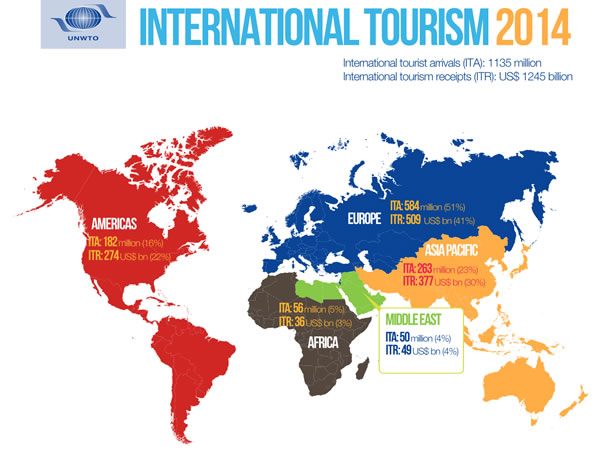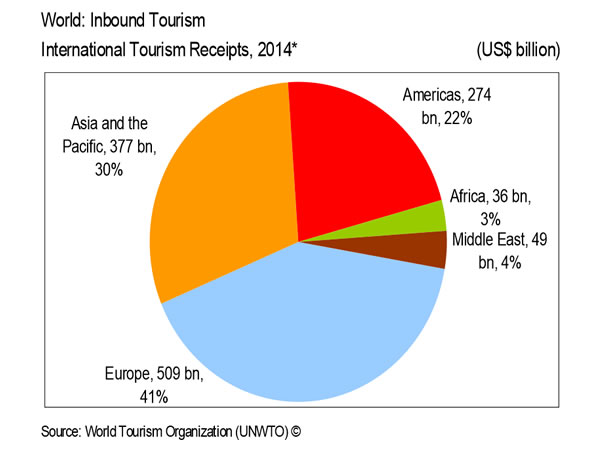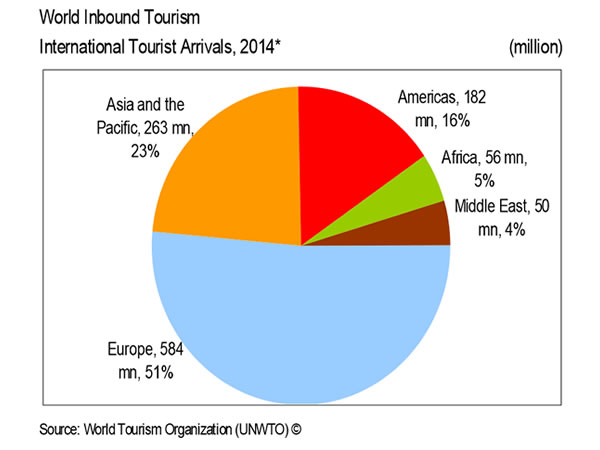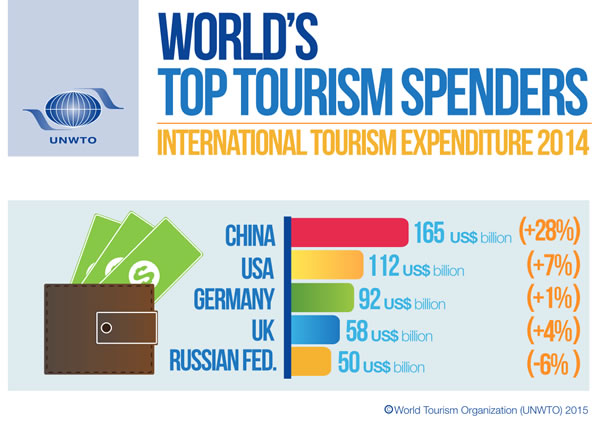 |
“In a scenario with decreasing commodity prices, spending on international tourism grew significantly in 2014, proving the sector’s capacity to stimulate economic growth, boost exports and create jobs.“ |
Taleb Rifai Secretary General UNWTO |
INTERNATIONAL. International tourism generated US$1.5 trillion in export earnings in 2014, according to the latest UNWTO World Tourism Barometer.
This figure, representing growth of +7.1% over 2013, is made up of an estimated US$1,245 billion in international tourism receipts – representing year-on-year growth of +3.7% in real terms (taking into account exchange rate fluctuations and inflation) – and US$221 billion in passenger transport services (rendered to non-residents).
International tourist arrivals increased by +4.4% in 2014, reaching a total of 1,135 million.
“International tourism is an increasingly significant component of international trade as seen in export earnings from international tourism and passenger transport, which reached US$1.5 trillion in 2014 (US$4 billion a day on average),” said UNWTO Secretary-General Taleb Rifai. “In a scenario with decreasing commodity prices, spending on international tourism grew significantly in 2014, proving the sector’s capacity to stimulate economic growth, boost exports and create jobs.”
International tourism (travel and passenger transport) represents 30% of the world’s exports of services and 6% of overall exports of goods and services. As a worldwide export category, tourism ranks fourth after fuels, chemicals and food, ranking first in many developing countries, according to UNWTO.
 |
Click on the above to view the enlarged image (then hover over graphs with your cursor and click for full detail) |
International tourism receipts grew in all regions
International tourism receipts – defined as receipts from international visitors spending on accommodation, food and drink, entertainment, shopping and other services and goods – saw growth across all regions in 2014.
Europe, which accounts for 41% of worldwide international tourism receipts, saw an increase in tourism earnings in absolute terms of US$17 billion (+3.5%) to US$509 billion.
Asia and the Pacific (30% share) saw an increase of US$16 billion (+4.4%), reaching US$ 377 billion. In the Americas (22% share), receipts increased by US$10 billion (+3.8%) to a total of US$274 billion. In the Middle East (4% share), tourism receipts increased by an estimated US$4 billion (+8.9%) to US$49 billion and in Africa (3% share) by US$1 billion (+2.9%) to US$36 billion.
By sub-region, Northern Europe, Southern and Mediterranean Europe, North East Asia, Oceania, South Asia, Caribbean, Central America, South America and the Middle East showed fastest growth in relative terms, all recording +5% or over in receipts.
 |
 |
Top earners: China and the UK move up in the top ten
In the top ten ranking by tourism earnings, China climbed from fifth to third place following a +10% increase in earnings to US$57 billion in 2014. The US (US$177 billion) and Spain (US$65 billion) maintained first and second positions in the ranking.
The UK (US$45 billion) moved up two positions to seventh, boosted by the lasting effects of the Olympics and the appreciation of the UK Pound (increasing receipts calculated in US dollar terms).
France, Macao (China) and Italy occupy the fourth to sixth positions respectively, while Germany, Thailand and Hong Kong (China) complete the top ten.
Top spenders: spending by advanced economies picks up
In terms of outbound tourism, the world’s top spender China continued its “exceptional” pace of growth with a +28% increase in expenditure in 2014, reaching a total of US$165 billion. While the two other major emerging markets among the first ten, the Russian Federation (-6%, fifth largest) and Brazil (+2%, tenth largest) lost strength, various advanced economy source markets picked up in growth.
The world’s second largest spender, the US posted a +7% increase. The UK spent +4% more and moved from fifth to fourth in the ranking. France increased expenditure by +11%, retaining the sixth position, and Italy by +6%, climbing from ninth to eighth.
Germany (third), Canada (seventh) and Australia (ninth) take the remaining places of the top ten.
 |




